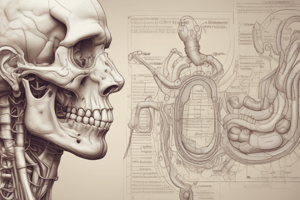Podcast
Questions and Answers
What is the basic structural and functional unit of life?
What is the basic structural and functional unit of life?
- Organ
- Cell (correct)
- Organ system
- Tissue
What is the function of the cell membrane?
What is the function of the cell membrane?
- To generate energy for the cell
- To store DNA
- To regulate what enters and leaves the cell (correct)
- To synthesize proteins
What is the function of epithelial tissue?
What is the function of epithelial tissue?
- To regulate what enters and leaves the body (correct)
- To provide support and structure to the body
- To generate energy for the body
- To transmit and process information
Which organ system is responsible for controlling and coordinating body functions?
Which organ system is responsible for controlling and coordinating body functions?
What is the term for the ability of the body to maintain a stable internal environment?
What is the term for the ability of the body to maintain a stable internal environment?
What is the function of the mitochondria?
What is the function of the mitochondria?
What is the function of the ribosomes?
What is the function of the ribosomes?
What is the term for the mechanisms that counteract changes in the body to maintain homeostasis?
What is the term for the mechanisms that counteract changes in the body to maintain homeostasis?
Flashcards are hidden until you start studying
Study Notes
Organization of the Human Body
- The human body is composed of:
- Cells: the basic structural and functional units of life
- Tissues: groups of similar cells that perform specific functions
- Organs: structures composed of two or more types of tissues that work together to perform specific functions
- Organ systems: groups of organs that work together to maintain homeostasis and perform specific functions
Cell Structure and Function
- Cell membrane: a thin layer of lipid and protein molecules that surrounds the cell and regulates what enters and leaves
- Cytoplasm: a gel-like substance inside the cell membrane where metabolic processes occur
- Nucleus: the control center of the cell where DNA is stored
- Mitochondria: organelles responsible for generating energy for the cell
- Ribosomes: organelles responsible for protein synthesis
Tissue Types
- Epithelial tissue: forms the lining of organs and glands, and regulates what enters and leaves the body
- Connective tissue: provides support and structure to the body, and connects organs and tissues
- Muscle tissue: responsible for movement and contraction
- Nervous tissue: responsible for transmitting and processing information
Organ Systems
- Nervous system: responsible for controlling and coordinating body functions
- Circulatory system: responsible for transporting oxygen and nutrients to cells, and removing waste products
- Respiratory system: responsible for exchanging oxygen and carbon dioxide
- Digestive system: responsible for breaking down and absorbing nutrients
- Endocrine system: responsible for producing and regulating hormones
- Immune system: responsible for defending the body against pathogens and disease
- Integumentary system: responsible for protecting the body from external damage and regulating body temperature
- Muscular system: responsible for movement and maintaining posture
- Skeletal system: provides support and structure to the body
- Urinary system: responsible for filtering waste and excess substances from the blood
Human Body Systems Interactions
- Homeostasis: the ability of the body to maintain a stable internal environment despite changes in external conditions
- Negative feedback loops: mechanisms that counteract changes in the body to maintain homeostasis
- Interactions between organ systems: the body's systems work together to maintain homeostasis and perform specific functions
Organization of the Human Body
- Human body is composed of cells, tissues, organs, and organ systems
- These components work together to maintain homeostasis and perform specific functions
Cell Structure and Function
- Cell membrane regulates what enters and leaves the cell
- Cytoplasm is the site of metabolic processes
- Nucleus is the control center of the cell where DNA is stored
- Mitochondria generate energy for the cell
- Ribosomes are responsible for protein synthesis
Tissue Types
- Epithelial tissue forms the lining of organs and glands, and regulates what enters and leaves the body
- Connective tissue provides support and structure to the body, and connects organs and tissues
- Muscle tissue is responsible for movement and contraction
- Nervous tissue is responsible for transmitting and processing information
Organ Systems
- Nervous system controls and coordinates body functions
- Circulatory system transports oxygen and nutrients to cells, and removes waste products
- Respiratory system exchanges oxygen and carbon dioxide
- Digestive system breaks down and absorbs nutrients
- Endocrine system produces and regulates hormones
- Immune system defends the body against pathogens and disease
- Integumentary system protects the body from external damage and regulates body temperature
- Muscular system is responsible for movement and maintaining posture
- Skeletal system provides support and structure to the body
- Urinary system filters waste and excess substances from the blood
Human Body Systems Interactions
- Homeostasis is the ability of the body to maintain a stable internal environment
- Negative feedback loops counteract changes in the body to maintain homeostasis
- Organ systems interact to maintain homeostasis and perform specific functions
Studying That Suits You
Use AI to generate personalized quizzes and flashcards to suit your learning preferences.




